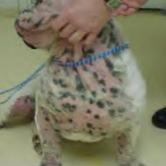Mange in Bulldogs

Demodectic mange (Demodecosis) is caused by an external parasite that is also present in low numbers on healthy animals, including people. Whether or not a pet shows symptoms of this disease depends primarily on their immune status. Since there is no easy test to determine immune status, it is impossible to predict which pets will get this disease, or how well a pet will heal if it shows symptoms of demodex.
It is important to note that the diagnosis of this skin condition, like most skin conditions, cannot be made just by looking at a pet. Diagnostic tests are mandatory to arrive at a correct diagnosis and achieve a satisfactory outcome to therapy. Stating that an animal looks "mangey" is not the same thing as making a positive diagnosis of mange. Pets that have Ringworm or Sarcoptic mange can look like they have demodex.
Demodectic mange is caused by a mite, a microscopic ectoparasite that infects the hair follicles. Most pups pick up these mites from their mother when they are nursing, and do not normally cause any problems. It is those pets that have an inadequate immune system that develop this disease.The parasite is cigar shaped and has several pairs of legs.It is only visible under a microscope.
There are underlying causes that can weaken the immune system and make a pet more susceptible to this disease. These include the chronic use of cortisone, Cushing's disease, heartworm, stress, cancer, and hypothyroidism. Adult dogs that have demodex take longer to treat than young dogs.
The primary way to diagnose demodectic mange is to do a skin scraping where the patches of alopecia occur. The fortunate thing about demodex is the ease of diagnosis in most dogs. In most cases the mites are easy to find under the microscope, and if your pet is diagnosed as having this disease, one of our staff members will show them to you. A positive skin scraping of large numbers of demodex mites, along with alopecia (remember demodex is naturally found in the skin also), is verification of demodectic mange and necessitates treatment.
We are fortunate to have several medications at our disposal to treat demodecosis. These medications have proven to be highly effective, and have saved many pets from suffering, and even euthanasia. Sometimes the most we can hope for is to control the problem, not cure it. Treatment duration needs to based on skin scrapings, not just the appearance of the skin. A skin that looks like it is healed can still harbor demodex mites. This is especially true for adult dogs with feet lesions.Unfortunately, due to the fact that the immune system is paramount in whether or not your pet gets this disease, no guarantee can be made that these medications will work. No matter which form of demodex is treated, several ancillary issues need to be addressed. Your pet needs to be on optimum nutrition, stay current on vaccines, and be free of internal parasites (worms).
This mixture is applied on the areas of hair loss daily. It is possible for localized demodex to progress to generalized demodex even if it is treated. Localized demodex might even resolve without any treatment. 2. Generalized Treatment Generalized demodex is treated with a combination of medications and modalities. It is important to understand that treatment may take 2-3 months to be effective. The hair is usually clipped to allow the topical medication easy access to the skin, which makes it substantially more effective. Secondary pyoderma (skin infection) is usually present also, so your pet is put on oral antibiotics for several weeks to months . The main drug used to treat generalized demodex is called Mitaban. Mitaban has to be used precisely by label instructions. It is difficult for people to do this properly in their homes. Pets are dipped once per week, in between these dips your pet should not be bathed. We continue dipping until successive skin scrapings are negative for mites. If Mitaban does not work there are other medications that are used with varying success to cure the problem.These include oral Ivermectin and Milbemycin (Interceptor). Side effects like excess salivation, incoordination, even coma and death are possible, so they must be used judiciously. They should not be given to Collies, Shelties, Australian shepherds, or dogs that are positive for heartworm. There can be no guarantee that they will work, especially in a disease that is so closely associated with the immune system. Spaying infected females is helpful.
Also understand that stress can be a cause of increased mites maybe like Teething, rabies shots given too early, prior to 4 months is too young because they are teething then and the shot just compounds the stress, going to a new home, stress from being introduced to new pets. I wait till they are 6 months old for rabies shots. Also Dr. Blakemore from Purdue who was the vet that formulated the Mitaban for use in dogs said not to dip dogs under 4 months and to wait 2 weeks between dips and this works well. Is it hereditary? Some cases may be, but most often it can be caused from a source like stress, or infection stress, and may not be hereditary in those cases. Just because your dog got it, don't mean it will be a problem in the future, if it was caused by non hereditary conditions like stress.







